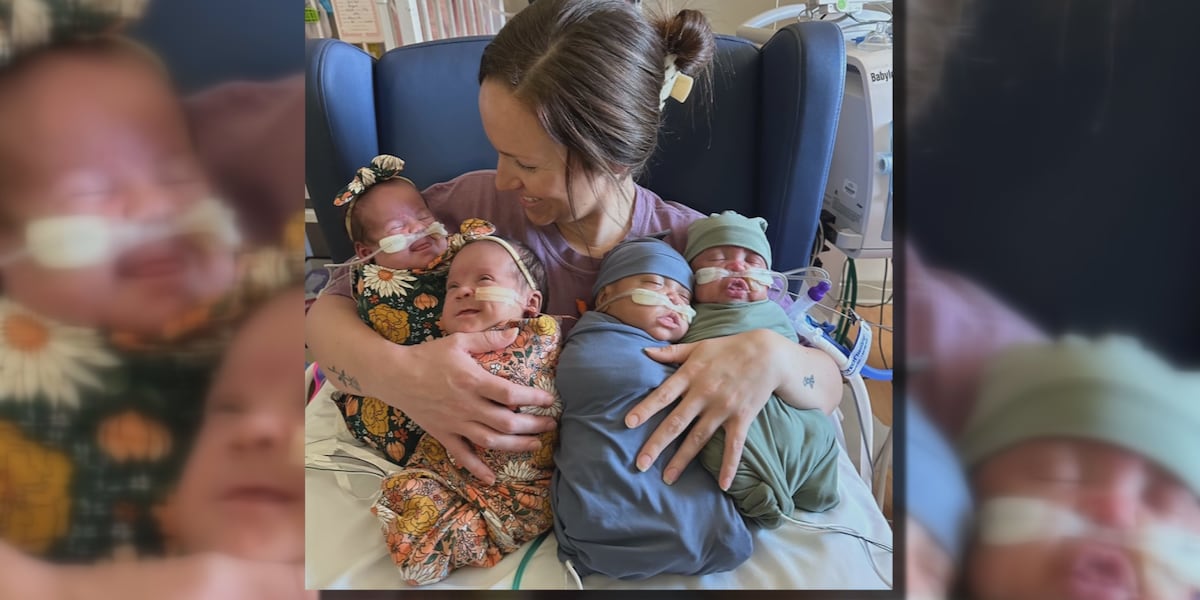California
Large stretches of California are without maternity care as hospitals close labor wards

These maternity ward closures have disproportionately impacted California’s low-income and Latino populations as well as communities where access to maternal care is already limited.
According to a CalMatters analysis of census tracts where closures have occurred, the median household income was about $12,000 less than in communities where maternity wards remain open.
Case in point: Imperial County on the U.S.-Mexico border.
The Imperial Valley is a sprawling agricultural region. About 86% of the county’s population identifies as Hispanic or Latino and close to 23% lives under the poverty line.
Even before the closure of El Centro’s maternity ward, Imperial County was designated a “low access” area for maternity care.
The number of births in Imperial County has been slowly declining, but the birth rate there is higher than the state average. In 2021, Imperial County saw 66.3 births per 1,000 women compared to California’s average of 53.5.
The closure of the maternity ward at El Centro means pregnant patients now either give birth at the sole other hospital in the county, Pioneers Memorial in Brawley, or they travel to neighboring counties, like San Diego or Riverside.
On its website, El Centro Regional Medical Center directs labor and delivery patients to hospitals as far as Yuma, Arizona and Palm Springs, one and two hours away by car. The hospital notes that in the case of an emergency, patients can still give birth in its emergency room, which experts say that while not life-threatening, is not an ideal scenario.
“The choices are limited, and so sometimes women have reported that there’s a delay in being able to get into the maternity ward,” said Adriana Ramirez, who manages maternal programs for Imperial County’s Public Health Department. “What else can they do?”
Calexico in Imperial County is home to about 38,000 people. The city doesn’t have its own hospital. Pregnant women there largely relied on El Centro’s hospital, some 13 miles away, to give birth. With the closure of that maternity ward, families now have to travel farther north. The trek from Calexico to Brawley isn’t unreasonable — it’s a 30-to 45-minute drive depending on traffic — but it’s a reminder that much-needed medical care is drifting farther away from this town.
“It creates a very troubling feeling in an area that already is medically underserved, and to move those services farther north really makes a lot of people nervous,” said Assemblyman Eduardo Garcia, a Democrat representing the Imperial Valley. “What I understand at the moment is that it is working out because there really isn’t any other option but to make it work.”The El Centro hospital and Pioneers Memorial released a joint statement when they announced the maternity ward closure that said one “unified” county-wide maternity ward would be a positive change. “We are confident that consolidating services will benefit all mothers and newborns,” Damon Sorenson, CEO of Pioneers Memorial, said in the statement.
Many closures and suspensions result from hospital systems consolidating maternity care into one location. Hospital representatives say consolidations can help maintain staff training and provide a higher level of care.
Yet stories of an overwhelmed maternity ward at Pioneers are circulating on social media and among residents. Some women have said they’ve experienced delays, although no one has reported being denied care.
Dr. Hamid Zadeh, an obstetrician who delivers at Pioneers Memorial, said the hospital is seeing significant demand that strains the capacity of its maternity ward.
“Sometimes we schedule inductions or deliveries for patients and they are getting put on hold because people keep coming and we have no nurse to take care of them,” he said.
Zadeh said medical staff monitor patients whose scheduled deliveries are delayed. “I understand it’s a concern that has always been there, but more recently with the closure of El Centro, it’s gotten worse.”
Blanca Morales, CEO of Calexico Wellness Center, a community clinic, said she hears these concerns from patients. “They’re full. That capacity is not there for our population.”
Morales grew up in the area and has seen the depletion of local medical services. After stints in other parts of the state and country, she came back home and in 2018 established the clinic. Next she’d like to open a birthing center — an ambitious goal, but a much needed service.
Bringing a birthing center and more OB-GYNS to Calexico would also open the doors for local women to get prenatal care sooner, she said.
There’s some evidence nationally that women receive less prenatal care and rates of preterm birth increase when maternity wards close particularly in rural counties. In the case of El Centro Regional Medical Center, the hospital is continuing prenatal care in its outpatient clinics.
Mothers in Imperial County receive the least amount of prenatal care in the state — only about 47% of pregnant women there receive prenatal care beginning in the first trimester compared to 83% statewide, according to the Centers for Disease Control and Prevention birth database.
Local providers say this low rate reflects a few of the area’s challenges: delayed care because of insufficient providers, a high rate of pregnant teens who are more likely to skip prenatal care, and also patients who may start receiving pregnancy care in Mexico before seeking services on the U.S. side.
Financial decisions by California hospitals
In the business of health care, perhaps nothing is more influential than the bottom line. Among the top reasons cited by hospital administrators and experts for this wave of closures is growing costs coupled with periods of financial stress.
Labor and delivery units often are the second-most expensive departments for hospitals to run, second only to emergency rooms which also require 24-hour staff, multiple administrators and health care researchers told CalMatters.
“Obstetrics units are often unprofitable for hospitals to operate,” said Caitlin Carroll, an assistant professor at the University of Minnesota whose research focuses on health economics and maternity care. “The cost of running an obstetric unit is quite high. Obstetric units have to be ready to take care of a patient 24 hours a day, they need clinical staff with specialized skills, they need specialized equipment, they need dedicated space for labor and delivery. All of that costs money.”
Jim Goerlich, president of the Petaluma Valley Hospital nurses union, said even if the maternity unit isn’t making money, the rest of the hospital is almost always profitable enough to make up the difference.
“Does that unit need to make money to be intrinsically valued?” Goerlich said.
Providence, the hospital operator, suspended maternity services indefinitely in May, maintaining that it was not a financial decision. In a statement, Chief Administrative Officer Troy Gideon said the hospital did not have enough clinicians to keep the ward running.
In San Diego County, administrators at Tri-City Medical Center said that the maternity ward closure was driven in part because of “current and expected financial losses”. Meanwhile, officials at the El Centro hospital in Imperial County said closing its maternity ward “was necessary for financial reasons.”

California
State of California confirms an increase in Social Security payments as of Dec. 30

The State of California has confirmed that Social Security beneficiaries will receive an increase in their payments beginning December 30, 2024. This 2.5% increase is part of the Cost of Living Adjustment (COLA) applied across the United States for 2025. The COLA is based on inflation rates to ensure beneficiaries maintain their purchasing power.
The December 30, 2024 Payment
The first payment reflecting this increase will be for Supplemental Security Income (SSI). Normally scheduled for January 1, this payment has been moved to December 30 due to the New Year’s Day holiday. This adjustment benefits millions in California and across the country, particularly those who rely on these funds for basic needs.
Types of Social Security Benefits
The Social Security program encompasses several types of benefits, all of which will see the 2.5% increase:
- Retirement Benefits: For individuals who have reached retirement age and contributed to the system during their working years.
- Disability Insurance (SSDI): For individuals unable to work due to a long-term disability.
- Supplemental Security Income (SSI): For low-income individuals, including seniors and people with disabilities.
- Survivor Benefits: Payments made to family members of deceased workers.
January 2025 Payment Schedule
Social Security payments are distributed based on the beneficiary’s birthdate. Here is the schedule for January 2025:
- January 3: Payments for those who receive benefits before May 1997 or who also receive SSI.
- January 8: Beneficiaries born between the 1st and 10th of the month.
- January 15: Beneficiaries born between the 11th and 20th of the month.
- January 22: Beneficiaries born between the 21st and 31st of the month.
The COLA increase will be reflected in all these payments.
Impact in California and Nationwide
California, home to more than 6 million Social Security beneficiaries, will see a significant impact from this adjustment. However, the increase is a nationwide policy benefiting over 70 million recipients across the United States.
This adjustment aims to ease the financial burden on Americans as they face rising living costs, reinforcing the commitment to support the nation’s most vulnerable citizens.
For more details about your payments, you can visit the official Social Security Administration (SSA) website.
California
Scientists document carnivorous squirrels in California who hunt voles : Short Wave

Squirrels are omnivores, eating nuts, fruit, small insects — and according to a study published in the Journal of Ethology — voles.
Sonja Wild, UC Davis
hide caption
toggle caption
Sonja Wild, UC Davis

Squirrels are omnivores, eating nuts, fruit, small insects — and according to a study published in the Journal of Ethology — voles.
Sonja Wild, UC Davis
Squirrels are on the hunt in the California Bay Area.
Their target: local voles.
In a study published in the Journal of Ethology, a group of California ground squirrels were found hunting, killing and eating a vole. Lead researcher and behavioral ecologist Jennifer Smith from the University of Wisconsin, Eau Claire says her team witnessed this behavior in the twelfth year of a long term study.
The local vole population boomed this year. It was five to six times bigger than normal, Smith says the squirrels took advantage of that.
But this behavior is not new. “There’s been accumulating evidence of one or two events within a species of a red squirrel taking a sparrow,” she says, also noting, “They tend to go, try to take chickens.”
But these accounts have been thought to be one-offs, generally.
With this study, the squirrels’ entire process was captured via video — and shown to be a regular part of these squirrels’ behavior.
Listen to Short Wave on Spotify and Apple Podcasts.
Listen to every episode of Short Wave sponsor-free and support our work at NPR by signing up for Short Wave+ at plus.npr.org/shortwave.
This episode was produced by Rachel Carlson and Jordan-Marie Smith and edited by Rebecca Ramirez, Christopher Intagliata and Ashley Brown. Tyler Jones checked the facts.
California
Top 25 California high school boys basketball rankings (12/26/2024)

The week between Christmas and New Year’s Day is always revealing for the best boys basketball teams in California and final days of the 2024 calendar year should be no different.
The Damien Classic and Torrey Pines Holiday Classic always present a window of what is in store for the rest of the season and separates the contenders and pretenders. Next weekend at the HoopHall Classic West in Gilbert (Ariz.), Jan. 2-4, will also give the elite teams time to strut their stuff.
There are nine teams among California’s Top 25 still unbeaten at Christmas, a pretty high number, including top-ranked St. John Bosco, No. 6 Riordan and No. 8 De La Salle and No. 9 Montgomery.
Note: Only teams that play for a CIF State California title were considered for this rankings, thus eliminating Prolific Prep of Napa Christian, which can and will play for a mythical national title. Notes and rankings below from Southern Section teams supplied by SBLive’s Tarek Fattal.
The Braves win their Trinity League opener over Orange Lutheran without Brandon McCoy and Elzie Harrington. Christian Collins and Max Ellis led the way. Next up: Platinum Division in Classic at Damien.
Roosevelt wins the Tarkanian Classic in Las Vegas, beating Notre Dame/Sherman Oaks in the final. Brayden Burries scored 26 points and Issac Williamson had 19.
Nik Khamenia notches 26 points, 10 rebounds and eight assists in a convincing win over JSerra, a team expected to earn an Open Division berth.
Notre Dame suffers its first loss in the Tarkanian Classic final to Roosevelt despite Tyran Stokes scoring 20 points. Lino Mark played just four minutes in an attempt to play while injured. (TYRAN STOKES DEBUT)
Four more wins started with 90-65 blowout of defending state D2 champion Oakland Tech behind 33 points and 10 points from Tounde Yessoufou, and a combined 45 from Julius and Malcolm Price along with Gunner Morinini. Yessoufou is averaging 29.8 points and 7.7 rebounds per game.
Won the Gridley Classic with wins over Branson (68-27), Clovis North (54-52) and previous No. 6 Salesian (52-51) thanks in part to tournament MVP Andrew Hilman (19 points). Texas Tech-bound Jasir Rencher and Irvine signee Nex Emeneke was also All-Tourney.
Pride lost their first regular-season game since 2022, 52-51 to Riordan, in finals of the Gridley Classic. Salesian missed two free throws with 1.2 seconds to play.
Win over Santa Margarita (61-57) to win the Vountour Classic was team’s most impressive. David Balogun, a rapidly improving 6-6 post, scored 29 to lead the way. Since then breathers over Mountain House (67-35), La Salle (76-26) and Sacred Heart Cathedral (79-39).
The Aztecs from San Diego won five games last week, including four at the Tarkanian Classic to take the Nike Division championship behind division’s Most Outstanding Player J.J. Sanchez, who had 22 points in the finals.
Eagles’ only loss comes this week to unbeaten NorCal power De La Salle, but bounces back with a win over Murrieta Valley.
Trailblazers beat Millikan 87-33 this past week.
The Lions get a taste of Open Division-level hoops in a 65-50 loss to Harvard-Westlake.
Redondo Union is picking up Open Division playoff buzz.
La Mirada has been idle since Dec. 14.
Coach Paul Tait is enthused by the play of sophomore point guard Dominic Loehle.
After lopsided win over St. Augustine (77-54), recorded tough wins over Sage Creek (75-66), Mission Hills (67-59) and La Jolla Country Day (80-68).
Monarchs have won five of their last six.
Pius went 2-2 at the Tarkanian Classic.
Jasone Crowe Jr. is averaging 37 points per game.
Had won four straight before losing 63-54 to Brophy College Prep of Phoenix Ariz. (63-54).
Quality win over Pacifica Christian of Orange County without Jeremiah Hampton was impressive. JJ Harris and Louis Bond impressed.
Canyon has won five straight. Brandon Benjamin averaging 30+ points a game.
Damien without big man Nate Garcia (injured).
Twelve straight wins isn’t a bad way to start the season. Defense a big key, holding opponents under 50 seven times, including three straight games limiting opponents to 49 in wins over Riverside poly (61-49), Salesian Los Angeles (93-49) and Wiseburn-Da Vinci (61-49).
Cougars last win came against Long Beach Poly on Dec. 14.
-
/cdn.vox-cdn.com/uploads/chorus_asset/file/24924653/236780_Google_AntiTrust_Trial_Custom_Art_CVirginia__0003_1.png)
/cdn.vox-cdn.com/uploads/chorus_asset/file/24924653/236780_Google_AntiTrust_Trial_Custom_Art_CVirginia__0003_1.png) Technology6 days ago
Technology6 days agoGoogle’s counteroffer to the government trying to break it up is unbundling Android apps
-

 News1 week ago
News1 week agoNovo Nordisk shares tumble as weight-loss drug trial data disappoints
-

 Politics1 week ago
Politics1 week agoIllegal immigrant sexually abused child in the U.S. after being removed from the country five times
-

 Entertainment1 week ago
Entertainment1 week ago'It's a little holiday gift': Inside the Weeknd's free Santa Monica show for his biggest fans
-

 Lifestyle1 week ago
Lifestyle1 week agoThink you can't dance? Get up and try these tips in our comic. We dare you!
-
/cdn.vox-cdn.com/uploads/chorus_asset/file/25672934/Metaphor_Key_Art_Horizontal.png)
/cdn.vox-cdn.com/uploads/chorus_asset/file/25672934/Metaphor_Key_Art_Horizontal.png) Technology3 days ago
Technology3 days agoThere’s a reason Metaphor: ReFantanzio’s battle music sounds as cool as it does
-

 Technology1 week ago
Technology1 week agoFox News AI Newsletter: OpenAI responds to Elon Musk's lawsuit
-

 News4 days ago
News4 days agoFrance’s new premier selects Eric Lombard as finance minister



















